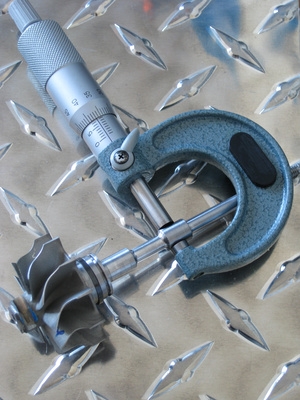
The oil pump in your vehicle provides the correct pressure so that oil reaches critical components inside the engine through a network of narrow galleries for proper lubrication. Because it is cheaper to install a new one than to rebuild, most auto shops will replace a worn out oil pump instead of taking the time to rebuild it. Still, you can check and service an oil pump at home and decide whether you should repair the pump or replace it.
Clean the oil pump thoroughly with solvent and let it air dry. Lay the oil pump on a workbench with the outer and inner rotor facing up. A rotary oil pump is about 3 to 4 inches thick and contains two rotors. The inner rotor rides inside the outer rotor.
Lift the outer rotor and inner rotors out of the pump body and measure the thickness of each rotor with an outside micrometer. Compare your measurement to the ones listed in the service manual for your specific vehicle's make and model. If the measurement does not conform with the specs in the service manual, replace the rotors.
Check the oil pump housing for damage. If you find groove or noticeable wear marks around the body or inside the rotors bore, replace the pump.
Replace the inner and outer rotor into the pump housing. Push one side of the inner rotor against the outer rotor and measure the gap on the opposite side between the inner rotor lobe and the outer rotor with a feeler gauge. Compare your measurement to the one listed in the owner's manual. If the measurement does not conform with the specs in the service manual, replace the rotors.
Position a straightedge on top of the rotors and measure the gap between the straightedge and the rotors with the feeler gauge. Compare your measurement with the wear tolerance provided in your service manual. If the measurement does not conform with the specs in the service manual, replace the rotors.
Measure the gap between the outer rotor and the housing with a feeler gauge. Compare your measurement with the one provided in your owner's manual. If the measurement does not conform with the specs in the service manual, replace the oil pump.
Reassemble the repaired pump using an oil pump repair kit for your specific vehicle's make and model. Dip the new pressure relief spring that comes with your kit in new engine oil before installing it. Pack the inner and outer rotor bore with petroleum jelly. Your repaired pump is now ready for reinstallation.
Clean the oil pump thoroughly with solvent and let it air dry. Lay the oil pump on the workbench with the gears facing up. A gear oil pump is about 4 to 6 inches thick in its gear housing and the two gears ride side by side. Their corresponding lobes mesh as they rotate.
Measure the gap between the lobe side of one of the gears and the lobe side of the other gear as they mesh together with a feeler gauge. Compare your measurement to the one listed in the service manual for your specific vehicle make and model. If the measurement does not conform with the specs in the service manual, replace the gears.
Make a note of the corresponding place of each gear in the housing and lift both gears out of the housing. Measure the gear bore depth with a depth micrometer. Measure the gear bore diameter, on the narrower side, with a telescoping gauge and measure the distance provided by the telescoping gauge with an outside micrometer. Compare your results with the corresponding measurements listed in your service manual. If the measurement does not conform with the specs in the service manual, replace the oil pump and gears.
Check the oil pump housing for damage. If you find groove or noticeable wear marks around the body or the gears bore, replace the pump.
Reinstall both gears into their corresponding bores and position a straightedge along the top of the oil pump, with the gears facing up. Measure the gap between the gears housing mating surface and the straightedge with a feeler gauge. If the measurement does not conform with the specs in the service manual, replace the pump.
Measure the clearance between one of the gear lobes and the gear bore wall with a feeler gauge. If the measurement does not conform with the specs in the service manual, replace the gears.
Reassemble the repaired pump using an oil pump repair kit for your specific vehicle's make and model. Before installing the new pressure relief spring that comes with your kit, dip the spring in new engine oil and pack the gears and bore with petroleum jelly. Your repaired pump is now ready for reinstallation.